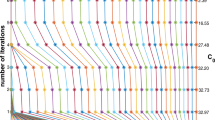Abstract
The numerical solution of a singularly perturbed problem, in the form of a two-dimensional convection-diffusion equation, is studied by using the technique of over-set grids. For this purpose the Overture software library is used. The selection of component grids is made on basis of asymptotic analysis. The behavior of the solution is studied for a range of small diffusion parameters. Also the possibilities of rotating the grid with the convection direction is considered.
The basic discretisation method is central differencing, and in order to fit global properties of the solution, the composite grid used is made parameter dependent. In view of possible ɛ-uniform convergence, in the resulting composite grid the number of grid points is kept constant for the different values of the small parameter. Only the grid spacing is adapted, depending on the parameters. We see that, even with such careful adaptation of the grid, in the discrete maximum norm no ɛ-uniform convergence is achieved.
Similar content being viewed by others
Explore related subjects
Discover the latest articles and news from researchers in related subjects, suggested using machine learning.Author information
Authors and Affiliations
Additional information
Received October 10, 1999
Rights and permissions
About this article
Cite this article
Havik, E., Hoffmann, W. & Hemker, P. Application of the Over-Set Grid Technique to a Model Singular Perturbation Problem. Computing 65, 339–356 (2000). https://doi.org/10.1007/s006070070004
Issue Date:
DOI: https://doi.org/10.1007/s006070070004



